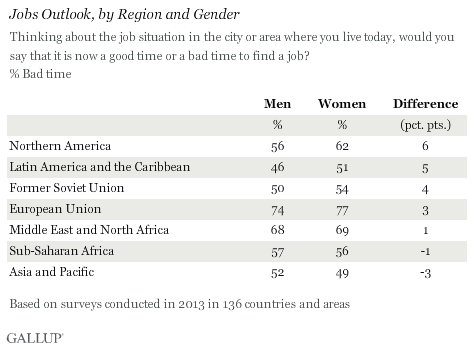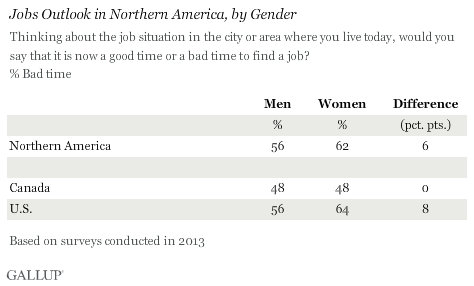Story Highlights
- Women (62%) more negative than men (56%) in Northern America
- Significant disparities between U.S. and Canada
- In Latin America, largest gender gap in Bolivia
WASHINGTON, D.C. -- The global jobs outlook remained about as dismal in 2013 as it was in 2012, and it was even more so for women than for men in some parts of the world. While men and women in most regions were more likely to say it was a bad time than a good time to find a job, women were more pessimistic than men in Northern America and Latin America and the Caribbean.

Women were also more pessimistic than men in the former Soviet Union and in the European Union, although not to the same degree as in the Americas. In the EU, where men and women were the most negative about job prospects, women were only slightly more likely to say it was a bad time to find a job (77%) than were men (74%).
Drastic Difference in Overall Views, Gender Gap Between Canada and U.S.
In general, Canadians were less pessimistic than Americans about their job prospects, but there were no differences between the views of Canadian men (48%) and Canadian women (48%). Since its passage in 1987, Canada's Pay Equity Act has seen the nation's gender pay gap slowly narrow. Additionally, the number of Canadian women in the workforce -- including women with children -- grew substantially between 1976 and 2012, outpacing the rate of men.
Americans, on the other hand, were decidedly more negative overall, and there was a substantial difference between the likelihood of American men (56%) and women (64%) to say it was a bad time to find a job. The differences between men and women in the U.S. -- which are possibly related to women's relatively lower incomes and a persistent gender pay gap -- account for all of the differences between men's and women's outlooks in Northern America.

Compared with residents in Latin America and the Caribbean, the gender gap in the U.S. was larger than most, although three countries saw even larger gender gaps in job market pessimism.
By far, the largest difference in negative views of the job market between men (38%) and women (55%) existed in Bolivia. This might be related to women's restricted access to education and cultural values that engender discrimination.
In Argentina, women were just as likely as Bolivian women to say it was a bad time to find a job (55%), although the gender gap between them and Argentinian men (45%) was considerably narrower. And in Brazil, less than half of men (38%) and women (47%) expressed negativity in job prospects -- though the gap between men and women was the third largest in Latin America.

Bottom Line
While men and women share a negative outlook about the job market where they live, at the end of the day, men are more likely than women to have full-time employment for an employer. Some of this is by choice, with women opting out of the workforce for cultural or social reasons. However, the disparity in the jobs outlook in the Americas and other regions shows a lopsided view of work opportunities that can further discourage women's participation. With growth slowing in many of the world's so-called "emerging economies," these perceptual gaps suggest a need to promote labor reforms that encourage women's participation.
These data and the breakdown by gender are available in Gallup Analytics. For complete data sets or custom research from the more than 150 countries Gallup continually surveys, please contact us.
Survey Methods
Results are based on telephone and face-to-face interviews with 137,387 adults, aged 15 and older, conducted in 2013 in 136 countries and areas. For results based on the total global sample, one can say with 95% confidence that the margin of sampling error is less than ±1 percentage point. For results based on the regional samples, the margin of error ranges from a low of less than ±1 percentage point in Europe to a high of ±2.2 percentage points in non-EU Europe. For results based on country-level samples, the margin of error ranges from a low of ±1.7 percentage points to a high of ±4.2 percentage points. The margin of error reflects the influence of data weighting. In addition to sampling error, question wording and practical difficulties in conducting surveys can introduce error or bias into the findings of public opinion polls.
For more complete methodology and specific survey dates, please review Gallup's Country Data Set details.
Learn more about how the Gallup World Poll works.

